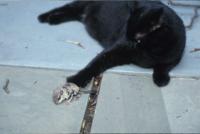If you have a dog or a cat, then you live with a predator in your loungeroom. Is that good or bad?
Predatory drive in pets is relatively common and sometimes a dog or cat’s prey drive can expand to become predatory aggression. Sometimes, that’s a problem.

For a wolf, its prey drive and therefore its predatory aggression is the reason why it chases, catches and kills a prey animal such as a rabbit or rodent. It does this to eat and to survive.
Domestic dogs are descended from wolves and in many cases, through domestication and purposeful breeding, we have polarised our modern-day dogs’ gene pool to focus on predatory aggression.
The ‘ratters’ such as Fox Terriers and Jack Russel Terriers chase rats and often kill them with a quick rat-shake to the neck because these breeds are predators. Other hunting breeds such as Spaniels and even Daschunds have strong prey drives.
A cat, of course, is the ultimate predator and a cat’s drive to chase things that move is legendary. Naturally when a cat chases a mouse, that’s predatory behaviour.
When a cat chases a piece of string that you drag along the ground – while we look at that as being play-based behaviour – it too is predatory behaviour.

It’s common for me to do a house call regarding a badly-behaved cat and to note the house is pristine clean and well-ordered. There’s nothing for the cat to ‘chase’.
The cat is sitting in the middle of this order and structure and yelling so quietly ‘for goodness sake CHANGE something and make it move.’
With tongue in cheek, I advise the owners to tip a bucket of cockroaches, geckos and grasshoppers on the floor – I see the owners freak but the cat says YES PLEASE!

Characteristics of predatory aggression
- It is often silent
- It often results in a lightning-quick approach to the prey animal and is therefore very dangerous if directed towards humans
- It is often a behaviour the dog or cat enjoys although it is dangerous and lethal for the receiving animal
- With dogs, it is often directed towards fast moving objects but thereby can be directed towards joggers, cyclists, skaters and running, screaming children.
- With cats, it is often directed towards the owner when he or she walks past.
- It often causes barking behaviour if the dog cannot get to its prey – for instance when a dog barks with frustration at a bird or possum in a tree or at a cat beyond a fence.
What’s different about predatory aggression?
Predatory aggression is different from other forms of aggression. Mostly, dogs and cats enjoy being predators. Almost without exception, other forms of aggression involve an ’emotion of distress’.
A cat chasing a mouse is enjoying itself. A Border Collie herding sheep is enjoying itself and two dogs playing tug-of-war with a toy are practicing predatory aggression but are enjoying themselves.
Sadly, a dog chasing a sheep and disembowelling it is also enjoying itself as is a dog that kills possums and cats.
Predatory aggression with cats is really deep-seated and is so innate that to not recognise it as an inbuilt need can even be harmful to cats.
If your cat shows ‘leg-latching’ aggression (where it runs out from under a chair – commits a Ninja-blade attack on your legs and runs off) it’s showing a need to be a predator. It’s probably bored out of its furry brain too.
What should you do about predatory aggression?
1. Not all aggression is predatory in nature. If your pet is aggressive, have the problem assessed.
2. Recognise predatory aggression is often deep-seated and part of being a dog or cat.
3. It can be dangerous when it’s directed towards live animals. Avoid contact with victim animals where possible.
4. Predatory aggression, especially when shown by working breeds, can be directed towards fast-moving people and even towards children. Be careful.
5. Pulsed, reward-based training can often control the aggression.
6. The aggression can often be diverted to more appropriate outcomes – especially with cats.
